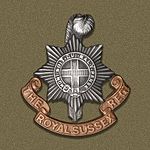
Robert Stanley Welchman
(known as 'Stanley')

11th (1st South Down) Battalion
Sergeant 131
 | Robert Stanley Welchman(known as 'Stanley') |  |
| Royal Sussex Regiment 11th (1st South Down) Battalion Sergeant 131 | ||
| Killed 13th September 1916 |
|
Assuming we have identified the correct individual, the
South Twerton School memorial contains the incorrect initials for Robert Stanley Welchman, who resided in Bath for a short period in 1908-1910. |
Stanley Welchman's Parents | ||
|
Stanley Lyne Welchman (father) Stanley Welchman’s father was Stanley Lyne Welchman, born in 1871 into a well-to-do farming family in West Lydford in Somerset. He appears on the 1871 census as a two-month old, with his father (Stanley (jun)'s grandfather) listed as a farm bailiff. The household was sufficiently well-off to afford a governess to look after Stanley and three other siblings, plus two servant staff. Ten years later, in 1881, Stanley’s father was listed as the farmer at Bridge Farm in West Lydford, with 487 acres and employing more than thirty farm hands in addition to a general servant at home. Stanley still lived with his parents in 1891, aged 20, when his father – retired from farming at the age of 55 – had taken the family to live in a large house on the sea front at Weston-super-Mare, looked after by three servants. By now, Stanley was a ‘civil engineer’. Lucy Mason (mother)Lucy Mason was born in 1871 in Belper, Derbyshire. In a horse-drawn age and in an industrial small town which was famous for producing elaborate hosiery, her father was employed as a groom. Lucy spent the first twenty years of her life living in a house in Gibfield Lane in Belper and at age 20 was listed as a dressmaker. Her elder sister Annie was one of the ‘Cheveners’, making the popular local stockings. | ||
The Welchman Family |
| We don’t know how Stanley (sen) and Lucy came to meet and be married in London, but their marriage is listed in 1894 at Holy Trinity church in Marylebone. This church has now been deconsecrated and functions as a showroom for household light fittings. Stanley (sen)’s farmer father had died earlier in the same year, aged just 58. Stanley (sen)’s entry on the marriage certificate is as a ‘Marine engineer’. |
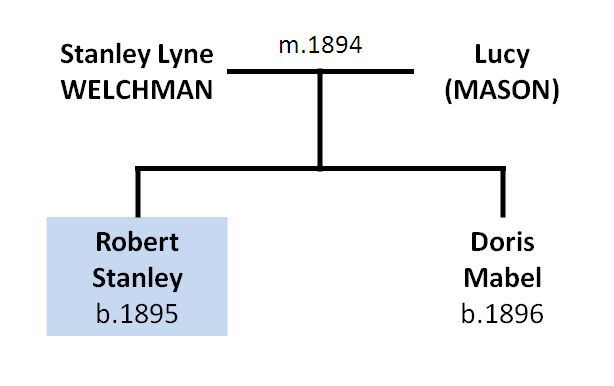 |
| Stanley (jun) was born in his mother's home town of Belper in 1895 and his younger sister Doris was born the following year, but back in London, this time in the district of the Customs House near the Tower of London. |
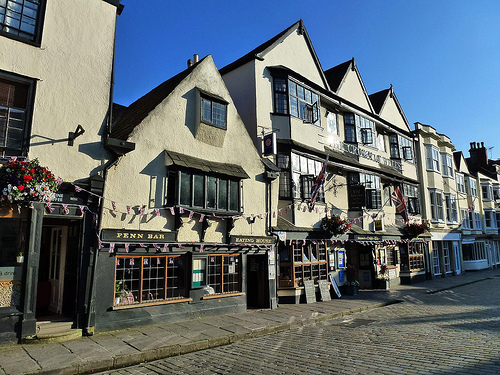 | ||
|
The Crown Inn at Wells, where Stanley (jun) seems to have lived for a time prior to his
father’s bankruptcy in 1900... IF this was the same Stanley Lyne Welchman!?. |
| It can be difficult to trace the history of a family if it moved around the country between censuses, but by November 1896, a 'Stanley Lyne Welchman' was running the Crown Inn on the market place in Wells. He next made the news in 1900 in connection with his bankruptcy there. We would assume that the rarity of the 'Lyne' name would point to this being Stanley senior, Stanley's father, but the following year’s census shows the Welchman family living in a large house in Lansdown Road, Clifton, Bristol. |
Move to Bath | ||
|
It isn’t until 1908 that the family makes an
appearance in
the Bath Directory, with Stanley (senior) listed as an insurance
agent living at 70 The Triangle (now 'Triangle North') in Oldfield Park.
Clippings from the Bath Chronicle and Weekly Gazette show Stanley (senior) engaging in local
political life from as early as January 1908 and becoming a stalwart of the
local Conservative and Unionist group in Twerton, presenting papers and convening
meetings, as well as travelling as far afield as Frome to attend evening
meetings there. He also took part in cycle races organised by Bath Cycling
Club on the Recreation Ground (1908), representing South Twerton and attended
the South Twerton evening school (1909), which seems to have been a part
educational / part social institution. | ||
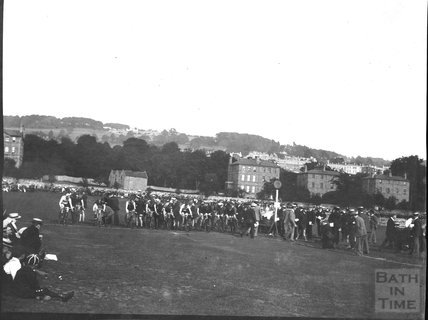 | ||
|
One of the cycle races held on Bath Recreation Ground in the early twentieth century, in which Stanley's father used to compete. [Image: Bath In Time] |
|
In 1909, Bath famously held a Pageant; a huge spectacle
which took place mainly in the Royal Victoria Park and Sydney Gardens over several
days, with tableaux depicting key episodes in the (pre-)history and folklore of
the city. It involved a very large proportion of the city’s inhabitants, with
everyone pulling together to develop costumes, music etc. Stanley Welchman (senior)
played his part as sub-leader of 'Group 2 of the invading army of Saxon
warriors'! |
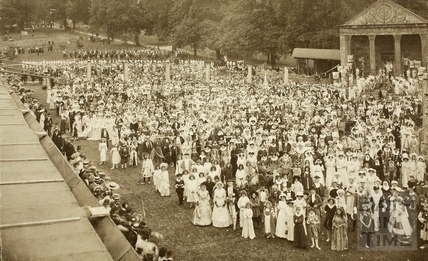 | ||
|
A scene from the Bath Pageant in 1909, in which Stanley's father played the part of a Saxon Warrior. Many more images of the Pageant can be seen at Bath In Time [Image: Bath In Time] |
| In
1910 the family had moved up the road to the very appropriately-named
Stanley Road (it later became 'Stanley Road
West', to distinguish from another Stanley Road off Manvers Street in
the centre of
Bath; this became necessary when Bath subsumed the parish of Twerton
and found itself with two roads with the same name - this was before
postcodes were thought of!). Stanley’s father had moved up in the world of insurance, listed in Directories as ‘Assurance Superintendant of the London Edinburgh & Glasgow Assurance Society’ (later Pearl Assurance) and the house was termed ‘District Headquarters’. |
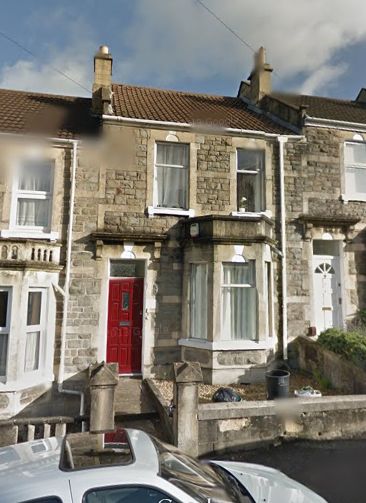 | ||
|
7 Stanley Road was the Welchman home - briefly - in 1910, before they moved away from the city |
Exeter, Eastbourne & Burnley | ||
|
The Bath Chronicle & Weekly Gazette of 17th November 1910 bemoans “A Loss to Bath Unionists”: “Chairman of the South Twerton Conservative & Unionist Association, Mr S L Welchman of 7 Stanley Rd, Oldfield Park, District Superintendant of the Pearl Life Assurance Company, leaves Bath on the 21st inst. to take up duties for the company as ordinary and accident inspector for the Exeter Division.” The 1911 census duly shows the family living in Heavitree, Exeter, with the 16-year-old Stanley listed as a clerk to a timber merchant. We know that the family went on to move to Eastbourne, Sussex, and then to Burnley, Lancashire, within a few years of leaving Bath. It is fair to say that if Stanley's early years were dominated by one theme, then it was a life on the move. | ||
Stanley Welchman (junior) in WW1 | ||
Royal Sussex Regiment: Eighteen months in England and thence to France Stanley Welchman served with the 11th Battalion of the Royal Sussex Regiment. This is taken from the excellent Lowther's Lambs website: “In September 1914, Colonel Claude Lowther, the owner of Herstmonceux Castle in Sussex and MP for the Eskdale constituency in Cumberland, received permission from the War Office to raise a Battalion of local men. He set up recruitment offices all over Sussex, but principally in the seaside towns of Hastings, Bexhill, Eastbourne, Brighton, Worthing and Bognor. Recruitment started on September 9th. Within two days 1100 men, from all walks of life, had volunteered. Originally designated the 9th Royal Sussex they later became the 11th, the 1st South Down Battalion.”
Although, by the time of the outbreak of war, we believe that Stanley had left Eastbourne to live in Burnley, he would have forged strong friendships while living in Eastbourne and perhaps not been in Burnley long enough to have done the same there. Hence he probably returned to Eastbourne in order to ensure that he was enlisting alongside close friends. A helpful post on the website 'armyservicenumbers.blogspot.com' (from which the above image is also sourced) further clarifies that the serial numbers 23-132 within the 11th Battalion were used, alphabetically by surname, for those enlisting in Eastbourne in September 1914. Thus Stanley Welchman's number 131 fits perfectly. At some point – probably at enlistment – Stanley gave his address in Eastbourne as 43 Cavendish Avenue; this is the address that later appeared on the town's Roll of Honour. It is not known whether this was the address where he had previously lived with his family, or whether he used the address of a friend for convenience.Stanley Welchman’s war records, including his attestation document, survive and show that he joined up on the very first day of recruitment in Eastbourne on 7th September 1914. The rubber stamp “9th Battalion” is crossed through by hand and replaced with “South Down Battalion”. The unit was nicknamed the “Lowther’s Lambs” in a reference to the breed of sheep also called ‘South Down’. The attestation also shows that Robert was a solicitor's clerk at the time. | ||
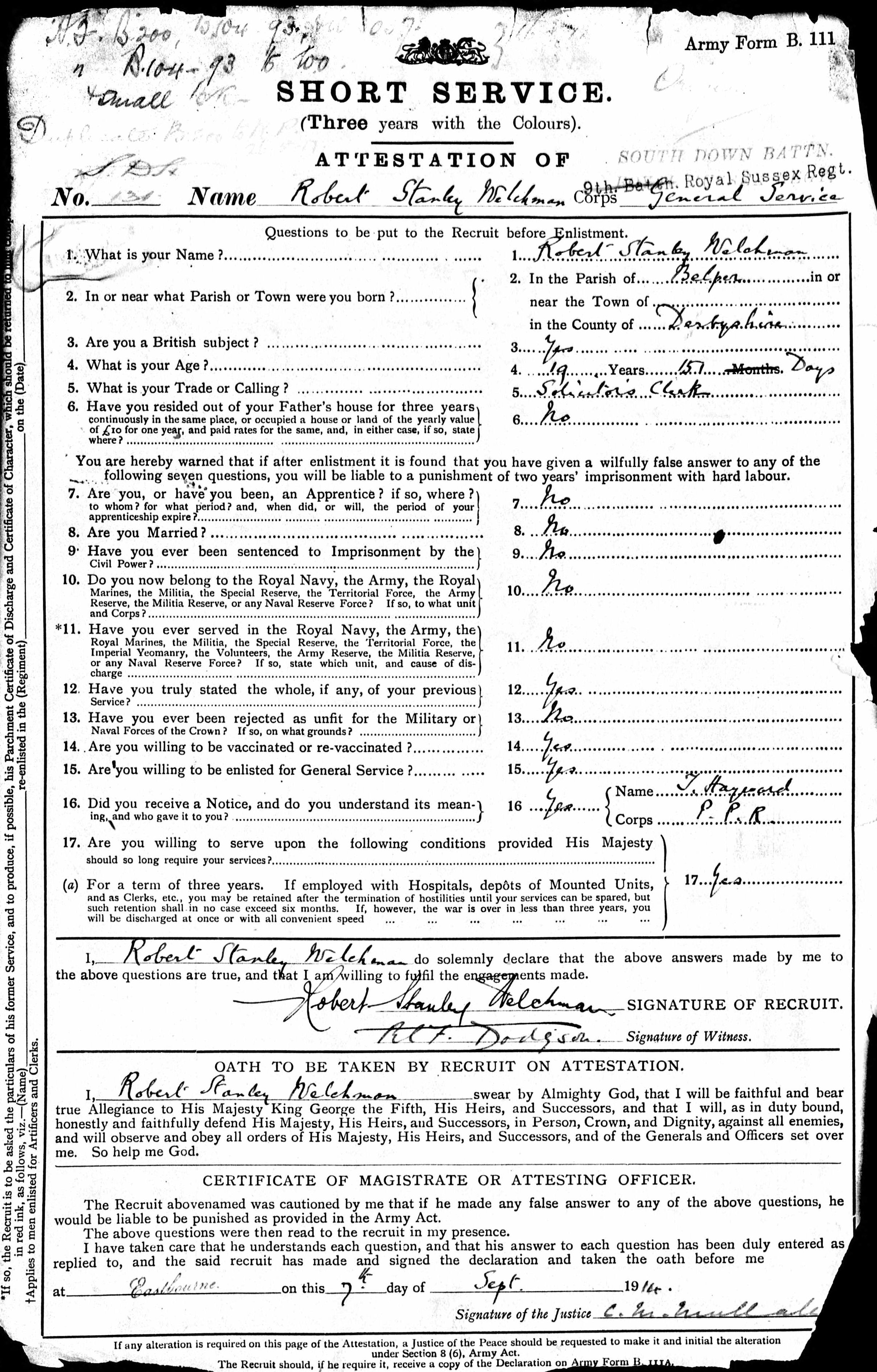 | ||
|
Stanley's attestation document |
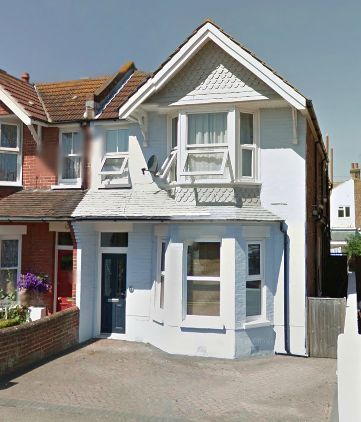 | ||
|
Stanley
is associated with the address 43 Cavendish Avenue in Eastbourne, but
it is not known whether he ever lived here or simply used it as a local
address for the purposes of enlistment |
At enlistment, Stanley was 5’5” tall and weighed 125 lbs, with a ‘fresh complexion, grey eyes and light brown hair’. Stanley's ‘Military History Sheet’ shows that the period 7.9.14 to 3.3.16 was spent in England. These first eighteen months in England were spent training and organising into battle Divisions etc. The initial period was spent at Cooden Camp, Bexhill-on-Sea. Hastily constructed to accommodate the new recruits, the camp initially accommodated the men under canvas, before hutments were constructed as the winter drew on.One very poetic contribution to the first-hand documentation of the War was a work called ‘Undertones of War’, by Edmund Blunden. Blunden was an officer in the Royal Sussex Regt. 11th Battalion – the same battalion as Stanley – albeit with ‘C’ Company, whereas Stanley was in ‘A’ Company. Blunden’s account of the fortunes of the 11th Battalion is all the more engaging for the fact that Stanley would have been involved in the actions described in the early part of the book. |
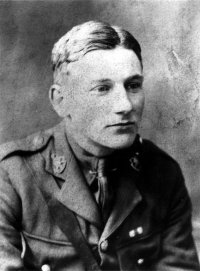 | ||
|
The poet Edmund Blunden who also served in the 11th Battalion of
the Royal Sussex Regiment and whose memoirs are among the most evocative
accounts of life on the Western Front |
| Some
excellent photographs of the 1st South Down Battalion (11th Bn., Royal
Sussex Regt) during its time at Cooden Camp have been generously shared by Paul Reed of Great War Photos. There is every likelihood that Stanley Welchman features somewhere in these photographs. |
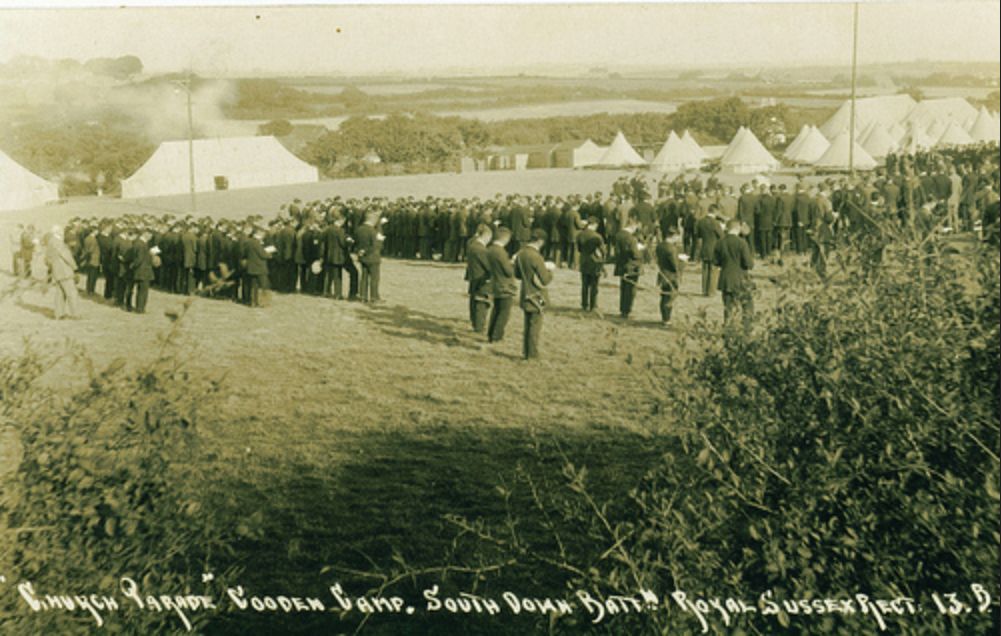 | ||
|
ABOVE:
A church service being held among the tents that formed Cooden Camp in
the early weeks of the war. BELOW: Inside one of the huts at
Cooden Camp for Christmas Lunch, 1914. Both photographs are labelled
and show Stanley's unit, the 1st South Down Battalion (11th Bn, Royal
Sussex Regt) | ||
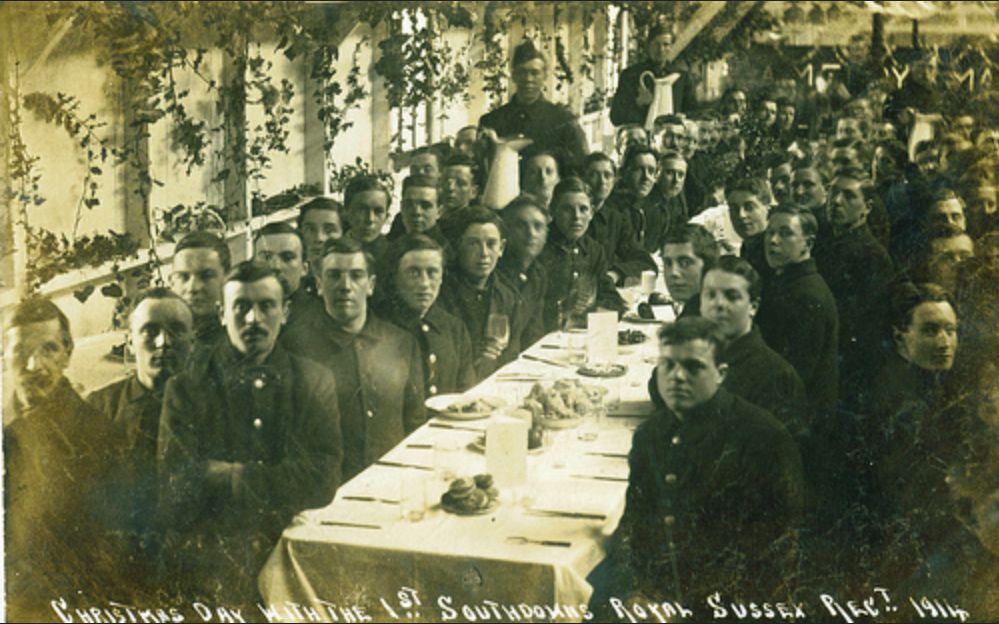 |
| Among
the most poignant artefacts to have come to light in the course of the
research on the 33 fallen servicemen on the South Twerton School plaque
is the following photograph, again from the collection of Paul Reed of Great War Photos. Taken in the early days of the war at Cooden Camp, prior to leaving for France, the photograph showing a group of happy young men in their prime, it provides a wonderful glimpse of the lighter side of life in uniform and was taken at a camp at Bexhill-on-Sea. The original photograph is hand-signed by six of the men. Second from bottom is the inscription 'R. S. Welchman' (note the similarity with the signature on the Attestation form, above). The Lowther's Lambs website tells us that only two of these men survived the war. |
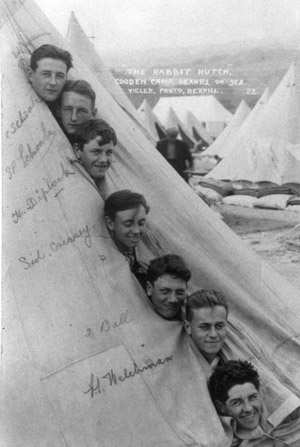 | ||
|
Stanley Welchman seen here (second from bottom) at training camp, in Sussex. Sincere thanks to Paul Reed of Great War Photos, for allowing the use of the photograph. |
|
Stanley attained the rank of Lance Corporal in February 1915, then in March was employed as ‘2nd soldier’ to manage pay and his fellow soldiers’ accounts (soldiers were paid but only drew money on an ‘as needed’ basis). He was promoted to Corporal in June 1915. The Battalion was moved to Detling Camp, Maidstone, in July 1915 and then adopted by the War Office. They moved to North Camp, Aldershot, in September 1915. In October 1915 they removed to Witley Camp (Witley Common, Surrey) and came under command of 116th Brigade in 39th Division. Stanley gained his ‘1st class musketry’ badge in
January 1916, while at Witley. |
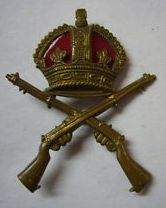 | ||
|
A WW1-era musketry badge |
|
On 4th March 1916, 39th Division was posted to active service in France. In ‘Undertones of War’, Blunden recalls the arrival of the 11th Sussex in France: “The evanescence of England beyond the waves and the imminence of France... and then the cloakroom at Boulogne Station. There was a train journey between verdurous banks and silvering poplars, ending drearily at Etaples, known as ‘Eatapples’ or ‘Heeltaps’. The Base! Dismal tents, glum roadways, prisoning wire." On the Lowther’s Lambs website is a brief description of the 11th Battalion’s introduction to the War, which includes: “After further training at Detling, Kent and at Witley Camp in Surrey, they sailed for France on March 4th 1916, landed at Le Havre and proceeded to Fleurbaix, France, a front line sector, for instruction and further training.” The following four months would have included training specific to trench warfare. Blunden mentions ‘gas school’ and describes a disastrous ‘rifle grenade training’ episode at which the instructor and several trainees were killed by a grenade exploding as it was fired. The unit quickly began to see active service, being moved around various sections of trench and rotated through roles in both support activities and the front line. Conditions in the trenches varied widely, but horrifying incidents of gory death and danger were never far away. In addition to direct engagements with the enemy, life at or near the front was also punctuated by more isolated incidents such as comrades falling victim to sniper fire and lone shells. Battle of the Boar’s Head (Richebourg)On 30th June 1916, the 11th Sussex were involved in the Battle of the Boar’s head. This was a fateful battle for the Sussex Regiment. For details of the battle, see the Wikipedia page: http://en.wikipedia.org/wiki/Richebourg-l'Avou%C3%A9 Blunden’s account in ‘Undertones of War’ (p61): “Before long, ‘secret’ attack orders came, which everyone had to know. The phrase was that ‘The following officers and men have been carefully selected to participate’ or some such honorific proscription. However, our battalion was supplying only various detached parties, the real assault falling to the share of the other three in the Brigade [12th & 13th Battalions, Royal Sussex Regt]… The German line ran out in a small sharp cape here, called the Boar’s Head (the line had several such: the Pope’s Nose, Caesar’s Nose, Duck’s Bill). This was to be ‘bitten off’, no doubt to render the maps in the chateaux of the mighty more symmetrical.” From the Lowther’s Lambs website: “On the 30th June 1916, in what was described as a 'diversionary' attack to distract the enemy from the great Battle of the Somme, which was due to start the following day, the 12th and 13th went over the top at Richebourg, France. The casualty list at the end of this disastrous day was 365 men killed or missing, and over 1000 wounded.” From Wikipedia: At Richebourg, in 1916, the 11th, 12th and 13th (Southdowns) Battalions
of the Royal Sussex, made up the 116th Southdowns Brigade of the 39th Division in Kitchener's New Army. On 30 June 1916 they took part in
the Battle of the
Boar's Head, Richebourg
L'Avoue. After a bombardment of the German trenches the 12th and 13th
Battalions went over the top (most for the first time) and, under heavy fire,
attacked the enemy trenches, bombing and bayoneting their way in. The 11th
Battalion supplied carrying parties. They succeeded in taking the German front
line trench, holding it for some four hours, and even briefly took the second
line trench for about half an hour, beating off repeated counterattacks, and
only withdrew from the shortage of ammunition and mounting casualties. Over a
period of less than five hours the three Southdowns Battalions of The Royal
Sussex lost 17 officers and 349 men killed, including 12 sets of brothers, of
whom three were from one family. A further 1000 men were wounded or taken
prisoner. In regimental history this is known as ‘The Day Sussex Died’. The following day the Battle of the Somme began and 20,000 died on the first day. The Royal Sussex attack at Richebourg was just a diversion, not even considered a separate action in the history of the war, and remains largely unmentioned in any of the official histories. Blunden (‘Undertones of War’, p62): “[Sergeant Compton] presently said the attack had failed. Of his party, none had returned without bullet holes in their caps, uniforms or equipment; one Single was already exhibiting his twice perforated mess-tin with his usual wit of dejection. In No Man’s Land a deep wide dyke had been met with, not previously observed or considered as an obstacle, which had given the German machine guns hideously simple targets; of those who crossed, most died against the uncut wire... “So the attack on Boar’s Head closed, and so closed the admirable youth or maturity of many a Sussex and Hampshire worthy... Our own trenches had been knocked silly and all the area of attack had been turned into an Aceldama... “Explanations followed. Our affair had been a cat’s paw, a ‘holding attack’ to keep German guns and troops away from the great gamble of the Somme. This purpose, previously concealed from us with success, was unachieved, for just as our main artillery pulled out and marched southward after the battle, so did the German; and only a battalion or two of reserve infantry was needed opposite us to secure a harmless little salient.” Stanley survived the Battle of the Boar’s Head, on which there is more information here: http://battlefields1418.50megs.com/boars_head.htm It isn’t certain what other actions the 11th Battalion were involved in as part of the subsequent Somme offensive (although Blunden’s account describes them remaining in support trenches in the Richebourg area, followed by a ‘calm’ period around Givenchy, Bethune, Monchy-Breton) and the Boar’s Head engagement is sometimes categorised as a part of the Somme offensive itself. Stanley's records show that he was first appointed Lance Sergeant on 3rd July, 3 days into the Battle of the Somme, then ‘Acting Sergeant’ on 13th and finally to the rank of Sergeant on 16th July. |
Missing at Hamel... and Death Confirmed | ||
|
Several weeks later, the unit was involved in operations at Beaucort-Hamel, on the Ancre, on 3rd September. The village of Beaumont-Hamel had been attacked on 1st July 1916 by 29th Division, with the 4th on its left and the 36th (Ulster) on its right, but without success. On 3rd September a further attack was delivered between Hamel and Beaumont-Hamel. This description is from http://www.1914-18.co.uk/blunden/ancreattack.htm: The task of the 39th Division, of which the 11th Royal Sussex was a part, involved attacking the German lines northwards towards Beaumont Hamel on a front of 1000 yards, together with the 14th Bn. Hampshire Regt. The 4th/5th Black Watch were set to work their way up the Ancre valley and keep in touch with the 49th Division attacking on their right flank. At first the assault by the Sussex and Hampshire men was successful, both battalions securing the German front line trenches against very little opposition. However, the Hampshires lost heavily and afterwards barely advanced any further. The 11th Royal Sussex met with better fortune and made some progress, some individuals actually reaching the German support and reserve trenches. Meanwhile, in the Ancre valley, the Black Watch suffered severely from machine gun fire and made very little progress. The men of the 49th Division on the Black Watch’s flank were quickly driven back from their start line in Thiepval Wood, Blunden reporting that the Division hardly got twenty yards from the edge of the wood. Blunden was employed in bringing up parties of men carrying bomb buckets full of grenades for the bombers manning the British trenches and for his work received the award of the Military Cross. The whole attack was unsuccessful and by the evening of 3rd September, the 11th Royal Sussex was relieved by the 6th Bn. Cheshire Regiment, going into billets at Englebelmer. The battalion casualties in the attack numbered some 300 men. The unit diary (WO95/2582) for 3rd September: 5.10 a.m. Operations commence, Artillery barrage opens. The Companies
left assembly trenches and reassembled in No-Mans-Land. Casualties were as follows: Officers killed – NIL Officers wounded – 3 Officers
missing – 8 Wounded – 160 Missing – 123 5.30 p.m. The Battalion was relieved by the Cheshire Regt. and went into billets at ENGELBELMER. A further, very detailed account of the fighting at Hamel can be read at: https://southdown.wordpress.com/2016/09/03/chapter-6-the-ancre-at-hamel/ Indeed, this blog gives a detailed account of the entire history of the South Down battalions of the Sussex Regiment. Stanley was wounded and was among the 123 who went missing in action in the attack of 3rd September. A report in the Burnley Express on 11th October 1916: | ||
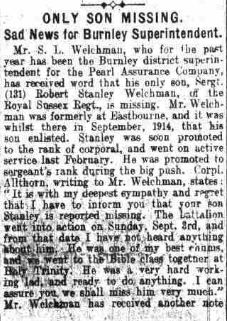  | ||
|
The Burnley Express report of Stanley's disappearance. it is from this that we know that Robert Stanley Welchman was known by his second given name. |
| The article was accompanied by a photograph of Stanley Welchman: |
|
We know, however, that by the time this report appeared in Burnley, Stanley had already died of his wounds – a shot wound to the pelvis – on 13th September 1916 while a prisoner of war in a ‘Feldlazarett’ (German field hospital) at Vehu. |
Burial | ||
|
It appears that Stanley was originally buried in a location called the Waldfriedhof (Woodland
Cemetery), but his grave is now in the Achiet le Grand Extension cemetery. This
was a cemetery begun by the Germans and also contains numerous New Zealand
soldiers. The British burials, of which Robert’s
is one, are in the minority. | ||
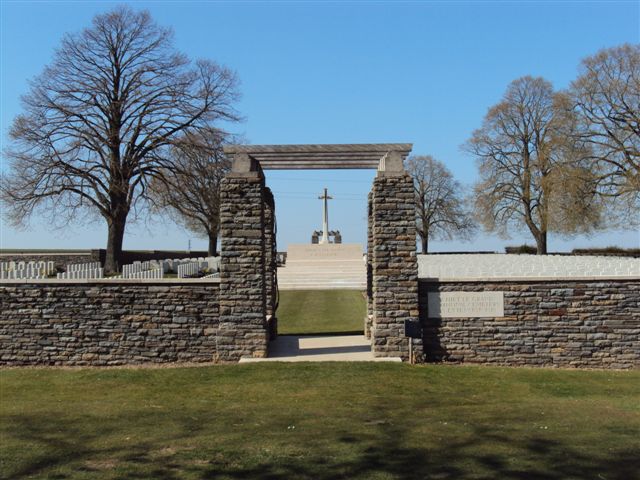 | ||
| Achiet le grand cemetery, where Stanley Welchman is buried | ||
Stanley's grave has been visited by Mike Sumsion, who regularly travels from Bath to visit graves of the city's fallen WW1 servicemen on the Western Front. He has kindly supplied the following photograph: 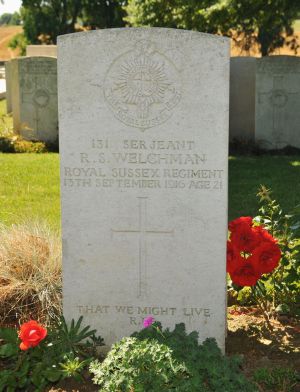 | ||
Decoration | ||
|
Sergeant Stanley Welchman would have received the following medals posthumously | ||
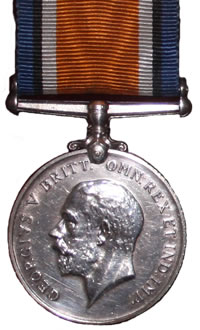 | 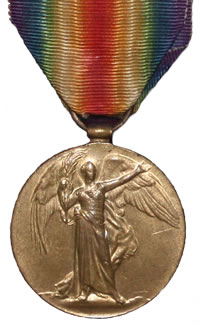 | ||
| British War Medal 1914-18 | Allied Victory Medal |
Commemoration | ||
 The inscription on the South Twerton School memorial has incorrect initials for Robert Stanley Welchman. There were no other Welchman families recorded in the district at the correct time. It is interesting to consider the process of gathering names for the South Twerton memorial; the family must have stayed friends with people in Bath for them to have found out about his death / service. In addition to his commemoration on the South Twerton School memorial, Sergeant Stanley Welchman is commemorated as follows: | ||
|
Eastbourne Town Memorial The Eastbourne memorial is in Devonshire Place and bears the words: “The tribute of Eastbourne to her gallant sons and daughters who were
faithful unto death in the Great War 1914-1918. Their names are recorded on oak
tablets in the Town Hall." |
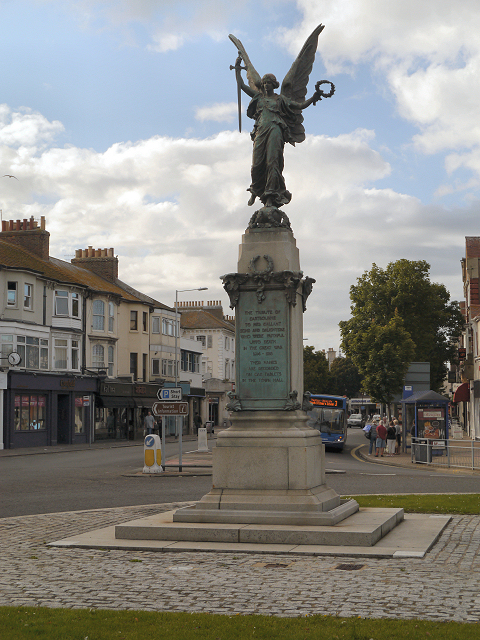 | ||
|
The Eastbourne War Memorial in Devonshire Place |
|
We may assume, therefore, that Stanley is commemorated on the oak panels at the top of the Memorial Staircase in the Town Hall and it would be great to obtain a photograph of his inscription. |
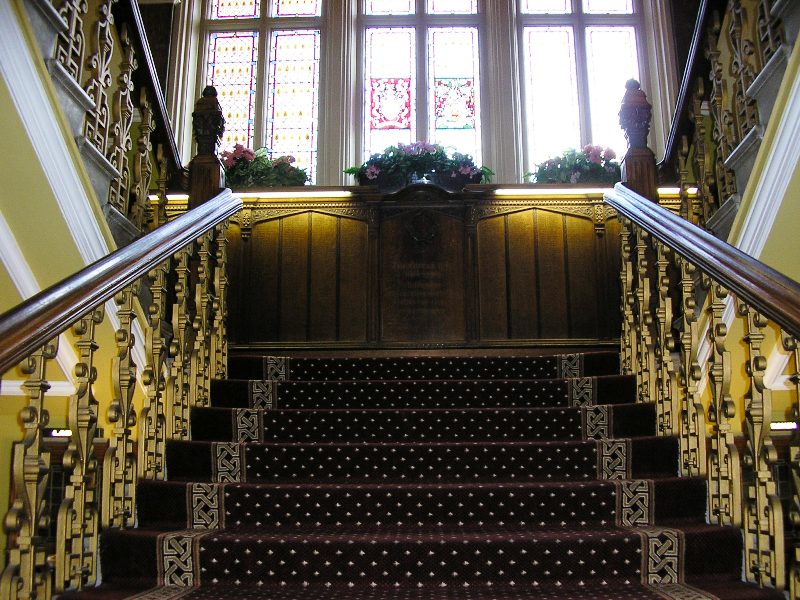 |
|
Eastbourne Roll of Honour From Eastbourne Roll of Honour: Robert Welchman. Sergeant SD.131, 11th Battalion, Royal Sussex
Regiment. 39th Division. Died of wounds in captivity 13 September 1916. Age 21.
Son of Stanley and Lucy Welchman of West Lydford, Somerset. Born in Belper,
Derbyshire and enlisted in Eastbourne. Employed in Eastbourne as a solicitors
clerk. Resident 43, Cavendish Avenue Eastbourne. |
|
St George's Chapel, Chichester Cathedral The cathedral at Chichester contains St
George’s Chapel, dedicated to the Sussex Regiment, which includes memorials
(names listed on oak boards, folding into wall-mounted cases) to those who fell
in WW1. |
|
The Sussex Regiment’s chapel at Chichester Cathedral. The folding boards visible on the walls (rear and left) contain the memorials listing the names of men who fell in WW1. |
|
Stanley Welchman is listed under Sergeants of the 11th Battalion: | ||
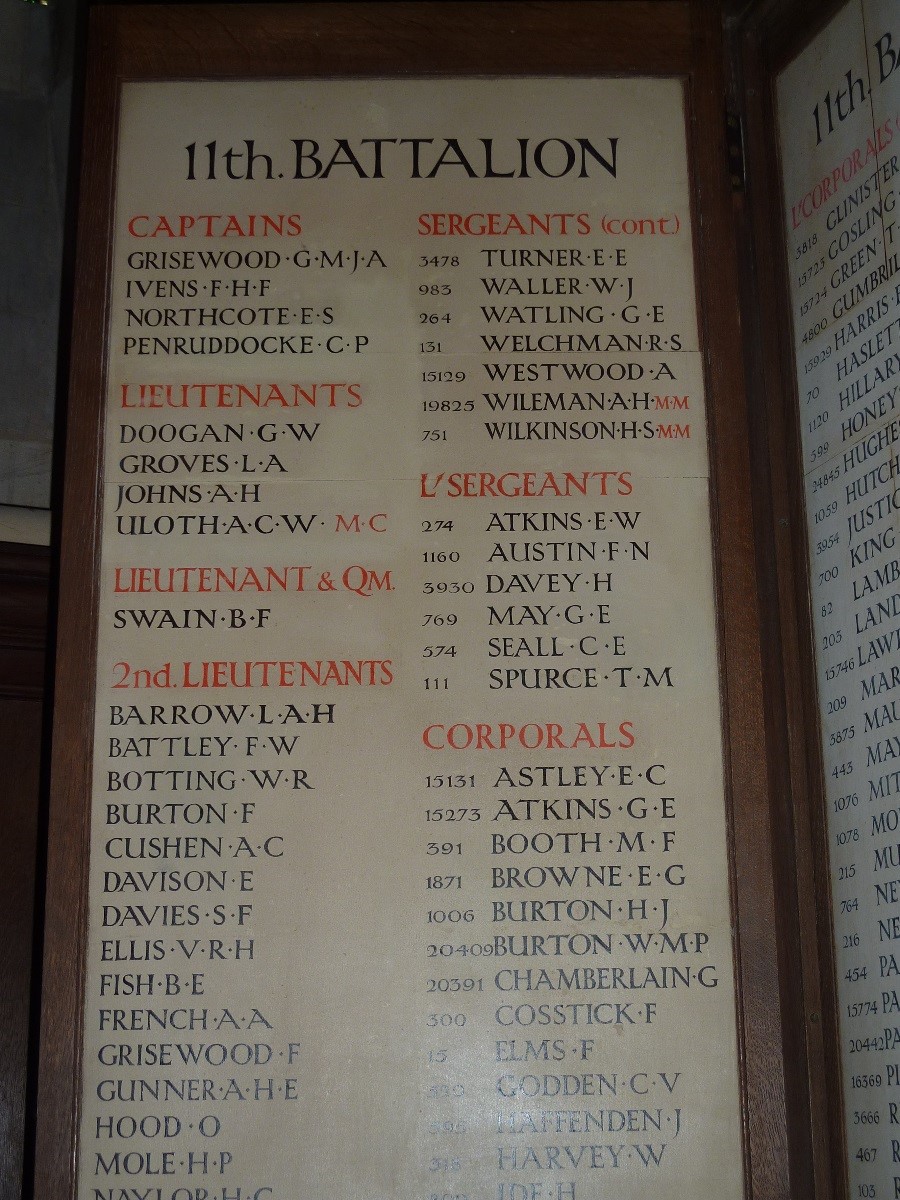 |
Further Information |
Other Family Members in WW1Other sources show that Stanley's father Stanley (senior) and his uncle Ernest (Stanley’s brother) were also both involved in the War. According to www.burnleyinthegreatwar.info, Stanley's ‘Uncle Ernest’ (or ‘Sergeant E.H.S. Welchman’) died in a railway accident at Laloma Vale in Australia in October 1916 (aged about 48) while serving with the Australian Army. He had emigrated to Australia prior to the war. In 1917 (at age 48!), the London Gazette shows that Stanley Welchman was made a temporary Lieutenant in the 11th Battalion of the Lancashire Volunteer Regiment. He would probably have been in ‘Z Company’ (‘The Burnley Pals’) who suffered major losses on the first day of the Battle of the Somme. Stanley's mother Lucy died in 1917, aged 46. By this time she had lost her only son, but we do not know whether her death predated her husband's enlistment or if she died while he was away. It is possible that Stanley (senior)'s enlistment was precipitated by the death of a son, wife and brother in a short space of time and a possible fatalistic outlook as a result. Stanley (senior)’s home address was given as 22 Howe Street, Burnley. Probate for Stanley (junior) lists his home address as having been 20 Hawthorn Road, also in Burnley. Living relativesIt would be great to hear from any living relatives of Stanley Welchman. These will probably be distant relatives, as Stanley's sister Doris died in 1964 in Lancashire as a spinster. Please get in touch!If you have any further information on Stanley Welchman, or want to suggest corrections / improvements for this page, please use the Contact page to get in touch.All additions and further information will be credited appropriately. |
Further Reading | ||
The following book by Edmund Blunden, who served in the same Battalion as Stanley, is a classic WW1 text and deals with many of the situations that Stanley would have faced. They would almost certainly have been known to each other:
| ||
 |